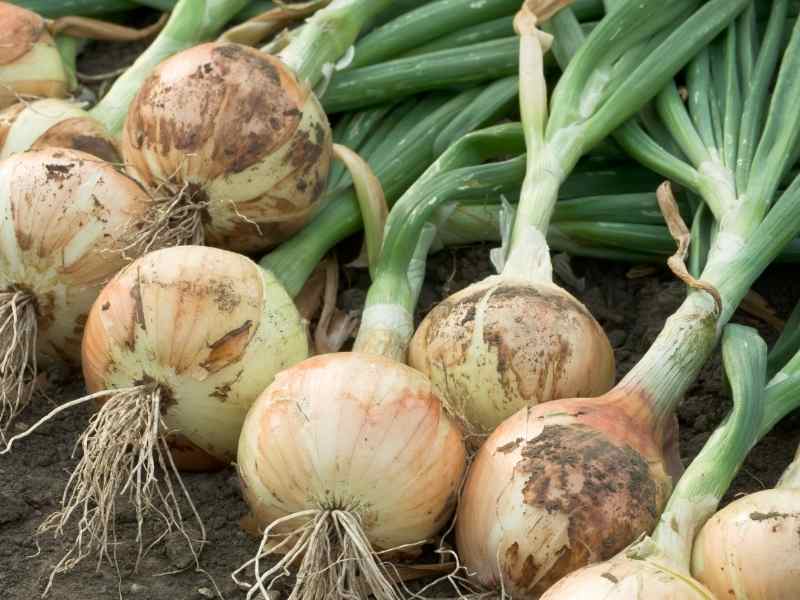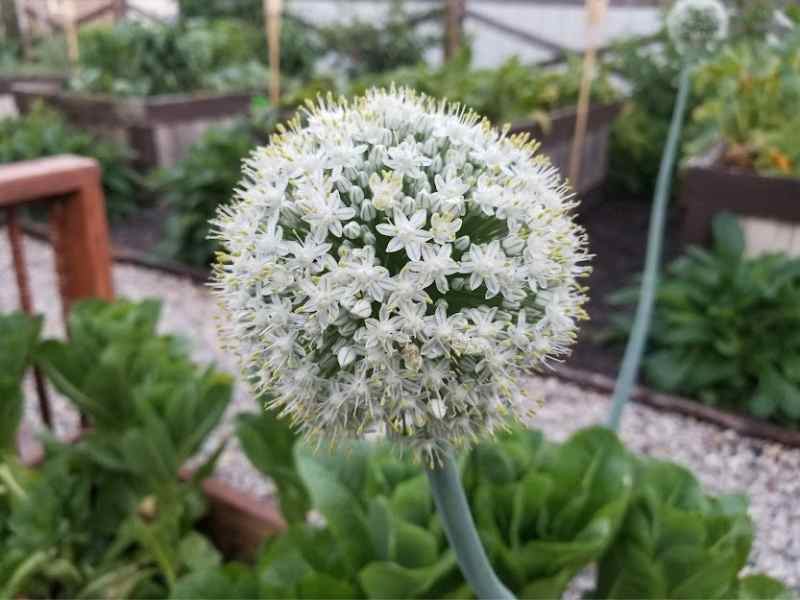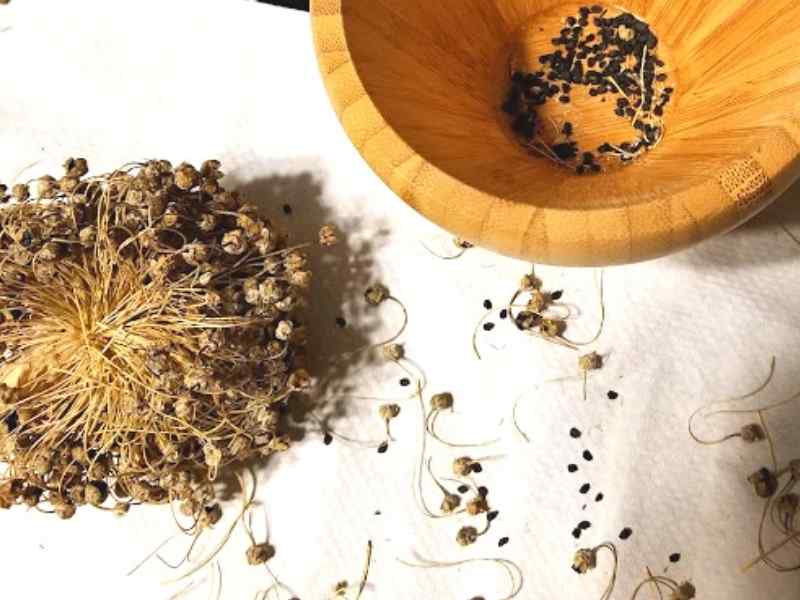Growing onions are easy, you go to your local farm supply store or get online and purchase your onion sets or bulbs and plant them in your garden.
But what if you want to be more self-sufficient and sustainable as a permaculture homestead? You can grow your onions from seeds you harvest from the previous year and it’s easier than you may think!

What Are The Benefits Of Growing Onions From Seed?
The Biggest Benefit Is Self-Sufficiency
Anytime you can close the loop on growing something on your permaculture homestead it is a step in the direction of self-sufficiency. When you can collect the seeds from your crops, plant them the next season and again grow your crop of choice to maturity, harvest, and collect the seeds again this is a closed loop system.
This means that you never have to bring anything in from outside your homestead to continue growing this crop over and over. With this comes a level of sustainability and preparedness that will provide you years of food security.
Cost Is Another Benefit
Although not a huge expense, when you don’t have to re-purchase onion sets or bulbs every year to provide the next crop it can save you a little money that is better spent on other things around the homestead.
What Are Some Disadvantages Of Growing Onions From Seed?
Takes More Time
Growing onions from seed takes a lot longer than from sets or bulbs. The seeds will have to be started indoors weeks before the last frost date in order to get a mature crop when you most want it.
It’s A Little More Work
Collecting seeds is a little work, starting seeds indoors is a little extra work, and hardening off the young tender plants is a little extra work. All in all, this adds up to quite a little bit of a little extra work.
Saving Onion Seeds
Letting Some Of Your Onions Go To Seed
To let your onions produce seeds you will need to leave them in the ground for two years because they are a Biennial plant. Onions will only bloom and produce seed in their second year.
This means you will have to select a portion of your crops that you won’t be harvesting at all or if winters are extremely harsh in your zone you may have to remove the bulbs in late fall, store them someplace cool (45-55 degrees), and replanted the next spring.
As the onions mature the second year they will send up a flower stalk with a beautiful globe of small flowers that will eventually become the seed head.

Harvesting The Onion Seeds
When the flower stalk turns brown and starts to drop and turn toward the ground it will be time to remove the seed heads. Cut the stalk below the seed head and store them in a paper bag in a cool place for a few weeks to allow them to completely dry.
You can shake the bags to get the seeds to fall out of the seed head and into the bag or crumple the seed heads over white paper towels to remove seeds. The seeds are small and black so using a white paper towel will help you see them.

Storing Onion Seeds
Like most seeds, you should store them in a cool dark place over the winter until you are ready to plant them which won’t be as late in the season as most plants.
When To Plant Onion Seeds
Onions are a cool-weather crop that has to grow around 90 days to reach maturity. Because of this, they need to be planted earlier than most crops when growing from seed.
Onion seeds should be started indoors under grow lights or in a temperature-controlled greenhouse 10-12 weeks before the average last frost date in your zone.
Find Your Average Last Frost Date
On The Old Farmer’s Almanac website they have a great tool called the Frost Dates Calculator where you can just put in your zip code and get the average last frost date for your area. This will help you to know exactly when you should be starting your onion seeds.
How To Plant Onion Seed
Seed Trays
I like to start by using the 72 cell seed starting trays with the watering trays they sit in for starting my onion seeds. I find these will be just fine for housing the seedlings until its time to transplant in the garden and you get the most bang for your buck because they hold so many plants.
- 🌱【𝗧𝗶𝗽𝘀】- These plant seed starter trays is suitable for...
- 🌿【𝗥𝗲𝘂𝘀𝗮𝗯𝗹𝗲 & 𝗦𝗮𝘃𝗲...
- 🥕【𝗚𝗿𝗲𝗮𝘁 𝗳𝗼𝗿 𝗦𝗮𝗽𝗹𝗶𝗻𝗴𝘀 &...
Last update on 2024-07-26 / Affiliate links / Images from Amazon Product Advertising API
No products found.
Proper Soil
You will want a good quality organic seed starting soil to start your onion seeds. I have had really good results for all my seed starting using Espoma Organic Seed Starter Premium Potting Mix but there are many good options out there.
- CONTAINS: This organic Seed Stating soil mix is a rich blend of sphagnum peat...
- MYCO-TONE: A blend of endo & ecto mycorrhizae.
- WHEN TO USE: Use to germinate and start seeds. Great for flower, vegetable, herb...
Last update on 2024-07-26 / Affiliate links / Images from Amazon Product Advertising API
Planting The Seeds
Plant 1 seed per cell about 1/4 inch deep. Onion seeds seem to have a really good germination rate so you should find that most if not all the cells will sprout an onion seedling.
How To Care For Planted Seeds and Seedlings
| Water Requirements | Keep evenly moist |
| Light Requirements | Full Sun or 10 to 12 hours under grow lights daily |
| Temperature | 70 to 75 degrees |
| Germination | 4 to 10 days |
Hardening Off Onion Seedlings
You can begin hardening off your seedlings about 2 weeks before your last average frost date to get them ready for transplanting into the garden. Hardening off your seedlings helps them adapt to the outdoor growing conditions without being shocked by the sudden change. It’s a way of easing them into the garden.
You can follow this chart below for best results but if you alter it a little it should be fine as onion seedlings aren’t as delicate as many seedlings.
Set your seed trays out according to this chart to harden off onion seedlings
| Day 1 | Partial Shade. Wind Protection | 1 Hour |
| Day 2 | Partial Shade. Wind Protection | 2 Hours |
| Day 3 | Partial Shade. Wind Protection | 3 Hours |
| Day 4 | Partial Shade. Wind Protection | 4 Hours |
| Day 5 | Partial Shade. Wind Protection | 5 Hours |
| Day 6 | Partial Shade. Wind Protection | 6 Hours |
| Day 7 | Partial Shade. Wind Protection | 7 Hours |
| Day 8 | Full Sun | 8 Hours |
| Day 9 | Full Sun | 10 Hours |
| Day 10 | Full Sun | All Day and Overnight If No Frost |
Transplanting Onion Seedlings
Prepare an area in your garden with full sun by either sheet mulching the area (which I’m a fan of) or tilling the soil (not a fan). Then add some compost to enrich the soil for your onions to get plenty of nutrients.
Now that you’ve hardened off your seedlings and the soil is ready it’s time to transplant them into your garden. Plant your onion seedlings around 12 inches apart and about 1-1/2 inches deep.
Caring For Young Onion Seedlings In Your Garden
Onions are pretty easy to grow if the soil is ideal for them and they get the right amount of water. Onions like moist but well-draining soil so to help with water retention, mulching with woodchips or straw is a good option.
Other than that sit back and relax as you wait a couple of months for your onions to reach maturity and start all over again.






